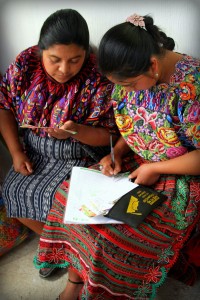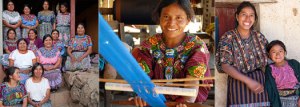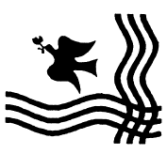Artisans from Guatemala have been participating in the Folk Art Market (FAM) for many years now. We learned about it from other weavers and embroiderers. It is one of the most prestigious folk art events in the world, and it has been a dream of ours to participate and share our hooked rugs with the world.
Since I speak English, Spanish, and Kaqchikel fluently, the women could share their thoughts and ideas with me, and I could incorporate them into the application. We know that the organisers are very selective, so we worked very hard on our application and are delighted that we have been chosen.
What is the history of the Cooperative?
The Cooperativa de Alfombras de Mujeres Maya en Guatemala grew from Mary Anne Wise and Jody Slocum’s, co-founders of Cultural Cloth (www.culturalcloth.com), original rug hooking project in Guatemala. Mary Anne Wise gave her first rug hooking workshop in Guatemala in June 2009. Its success led to other workshops where she taught students more advanced techniques. In 2012, the Delta Foundation supported a Rug Hooking Teacher Training Program. A core group of seven women were trained to teach others rug hooking techniques. Today, over fifty women from six highland villages are rug hooking, and we have organized ourselves into a cooperative. Our folk art combines the art of rug hooking with design elements and colors inspired by motifs present in the traditional clothing, folklore, and culture of Guatemala.

Yolanda Calgua (left) discussing design with a new student Estella Alvarado from the Totonicipan rug hooking group. Photo by Rachel Green
Tell us a bit about your other delegate.
Yolanda Calgua is thirty-four years old, married with two children. She lives in the rural community of Quiejel, Chichicastenango. She has helped many women in her community realize their potential. She believes strongly in the power of women to bring about positive social change. Everyone who has met Yolanda has been struck by her energy, vitality, and motivation, she is truly an inspiring woman. Two years ago potable water came to her village. Income from the sale of her rugs allowed her to buy the faucets and piping for six families to tap into the pipe.
Of rug hooking she says, “it is a privilege to be a rug hooking teacher and bring this opportunity to women in other communities. My hope is that they can make a better life for themselves and their children.” She still remembers hooking her first rug; it was made in memory of her grandmother and incorporated designs she remembers from her grandmother’s huipil (the traditional blouse worn by indigenous woman in Guatemala). Rug Hooking is also something that fits around her life as a wife and mother.







